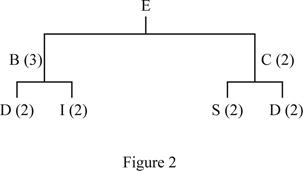
Concept explainers
a. One hundred twenty units of end item Z are needed at the beginning of week 7. Prepare a material requirements plan for component C. Take into account that on hand there are 40 units of Z, 70 units of A, 100 units of B, and 30 units of C. Also, there is a

b. Ninety-five units of end item E are needed at the beginning of week 7. Prepare a material requirements plan for component D. Take into account that 5 units of E are currently on hand, as well as 50 units of B, 100 units of C, and 80 units of D. Also, 30 units of C have been outsourced and are expected to arrive in week 4. Lead times are two weeks for E and C. and one week for the other components. Assume lot-for-lot ordering except for D. where multiples of 40 must be used.

a)
To prepare: A material requirements plan for Component C.
Introduction: Materials Requirement Planning (MRP) is the planning or scheduling system, which can be used in the manufacturing process. It is used to plan the number of items required to produce one unit of finished goods (end item)
Explanation of Solution
Given information:
120 units of end item (Z) are required at the beginning of Week 7. It is given that 40 units of Component Z, 100 units of Component B, 70 units of Component A, and 30 units of Component C are available on hand. Scheduled receipt is 20 units of Component C in Week 4. Lead-time is given as 2 weeks for Component Z and Component B and 1 week for other components. Lot size is lot-for-lot.
In addition to the above information, the following diagram is given:

Prepare a Material Requirement Plan (MRP) for Component Z:

- Gross requirement is given as 120 units at the beginning of Week 7.
- On-hand inventory is 40 units. It remains same until Week 6, as there is no demand.
- Net requirement can be calculated by subtracting the projected on hand inventory of previous week from the gross requirement of current week.
- 80 units are required at the beginning of Week 7. Hence, they need to order for 80 units (as the lot size is lot-for-lot) before two weeks (as the lead-time is 2 weeks), which means on Week 5.
- Projected on-hand inventory is calculated by adding the scheduled receipts and the value attained by subtracting gross requirements from the sum of projected on-hand of previous week and planned order receipt of previous week.
Prepare a Material Requirement Plan (MRP) for Component A (2):

- Component Z is the parent item of Component A (2). As the number of Component A is 2, the planned order release should be multiplied with 2 to determine the gross requirement of Component A.
- On-hand inventory is 70 units. It remains same until Week 4, as there is no demand.
- Net requirement can be calculated by subtracting the projected on hand inventory of previous week from the gross requirement of current week.
- 90 units are required at the beginning of Week 5. Hence, they need to order for 90 units (as the lot size is lot-for-lot) on previous week (as the lead-time is 1 weeks), which means on Week 4.
- Projected on-hand inventory is calculated by adding the scheduled receipts and the value attained by subtracting gross requirements from the sum of projected on-hand of previous week and planned order receipt of previous week.
Prepare a Material Requirement Plan (MRP) for Component B (4):

- Component Z is the parent item of Component B (4). As the number of Component B is 4, the planned order release should be multiplied with 4 to determine the gross requirement of Component B.
- On-hand inventory is 100 units. It remains same until Week 4, as there is no demand.
- Net requirement can be calculated by subtracting the projected on hand inventory of previous week from the gross requirement of current week.
- 220 units are required at the beginning of Week 5. Hence, they need to order for 220 units (as the lot size is lot-for-lot) on two weeks before (as the lead-time is 2 weeks), which means on Week 3.
- Projected on-hand inventory is calculated by adding the scheduled receipts and the value attained by subtracting gross requirements from the sum of projected on-hand of previous week and planned order receipt of previous week.
Prepare a Material Requirement Plan (MRP) for Component C (3) and C (2):

- Component A (2) is the parent item of Component C (3) and Component B (4) is the parent item of Component C (2). As the number of Component C is 3, the planned order release of Component A should be multiplied with 3 to determine the gross requirement of Component C. The same should be followed for Component C (2) with its parent item B (4).
- On-hand inventory is 30 units. It remains same until Week 3, as there is no demand.
- Net requirement can be calculated by subtracting the projected on hand inventory of previous week from the gross requirement of current week.
- 410 units are required at the beginning of Week 3. Hence, they need to order for 410 units (as the lot size is lot-for-lot) on previous week (as the lead-time is 1 week), which means on Week 2.
- Projected on-hand inventory is calculated by adding the scheduled receipts and the value attained by subtracting gross requirements from the sum of projected on-hand of previous week and planned order receipt of previous week.
- Projected on-hand inventory is calculated by adding the scheduled receipts and the value attained by subtracting gross requirements from the sum of projected on-hand of previous week and planned order receipt of previous week.
b)
To prepare: A material requirements plan for Component D.
Introduction: Materials Requirement Planning (MRP) is the planning or scheduling system, which can be used in the manufacturing process. It is used to plan the number of items required to produce one unit of finished goods (end item)
Explanation of Solution
Given information:
95 units of end item (E) are required at the beginning of Week 7. It is given that 5 units of Component E, 50 units of Component B, 80 units of Component D, and 100 units of Component C are available on hand. Scheduled receipt is 30 units of Component C in Week 4. Lead-time is given as 2 weeks for Component E and Component C and 1 week for other components. Lot size is lot-for-lot for all the components except Component D. Lot size for Component C is multiples of 40.
In addition to the above information, the following diagram is given:

Prepare a Material Requirement Plan (MRP) for Component E:

- Gross requirement is given as 95 units at the beginning of Week 7.
- On-hand inventory is 5 units. It remains same until Week 6, as there is no demand.
- Net requirement can be calculated by subtracting the projected on hand inventory of previous week from the gross requirement of current week.
- 90 units are required at the beginning of Week 7. Hence, they need to order for 90 units (as the lot size is lot-for-lot) before two weeks (as the lead-time is 2 weeks), which means on Week 5.
- Projected on-hand inventory is calculated by adding the scheduled receipts and the value attained by subtracting gross requirements from the sum of projected on-hand of previous week and planned order receipt of previous week.
Prepare a Material Requirement Plan (MRP) for Component B (3):

- Component E is the parent item of Component B (3). As the number of Component B is 3, the planned order release should be multiplied with 3 to determine the gross requirement of Component 3.
- On-hand inventory is 50 units. It remains same until Week 4, as there is no demand.
- Net requirement can be calculated by subtracting the projected on hand inventory of previous week from the gross requirement of current week.
- 220 units are required at the beginning of Week 5. Hence, they need to order for 220 units (as the lot size is lot-for-lot) on previous week (as the lead-time is 1 weeks), which means on Week 4.
- Projected on-hand inventory is calculated by adding the scheduled receipts and the value attained by subtracting gross requirements from the sum of projected on-hand of previous week and planned order receipt of previous week.
Prepare a Material Requirement Plan (MRP) for Component C (2):

- Component E is the parent item of Component C (2). As the number of Component C is 2, the planned order release should be multiplied with 2 to determine the gross requirement of Component C.
- On-hand inventory is 100 units. It remains same until Week 3, as there is no demand. Scheduled receipts of 30 units arrived on Week 4. Hence, the on-hand inventory is 130 units on Week 4.
- Net requirement can be calculated by subtracting the projected on hand inventory of previous week from the gross requirement of current week.
- 50 units are required at the beginning of Week 5. Hence, they need to order for 50 units (as the lot size is lot-for-lot) on two weeks before (as the lead-time is 2 weeks), which means on Week 3.
- Projected on-hand inventory is calculated by adding the scheduled receipts and the value attained by subtracting gross requirements from the sum of projected on-hand of previous week and planned order receipt of previous week.
- Projected on-hand inventory is calculated by adding the scheduled receipts and the value attained by subtracting gross requirements from the sum of projected on-hand of previous week and planned order receipt of previous week.
Prepare a Material Requirement Plan (MRP) for Component D (2) and D (2):

- Component B (3) is the parent item of Component D (2) and Component C (2) is the parent item of Component D (2). As the number of Component D is 2, the planned order release of Component B should be multiplied with 2 to determine the gross requirement of Component D. The same should be followed for Component D (2) with its parent item C (2).
- On-hand inventory is 80 units. It remains same until Week 3, as there is no demand.
- Net requirement can be calculated by subtracting the projected on hand inventory of previous week from the gross requirement of current week.
- 20 units are required at the beginning of Week 3. Hence, they need to order for 40 units (as the lot size is multiples of 40) on previous week (as the lead-time is 1 week), which means on Week 2.
- Projected on-hand inventory is calculated by adding the scheduled receipts and the value attained by subtracting gross requirements from the sum of projected on-hand of previous week and planned order receipt of previous week.
- Projected on-hand inventory is calculated by adding the scheduled receipts and the value attained by subtracting gross requirements from the sum of projected on-hand of previous week and planned order receipt of previous week.
Want to see more full solutions like this?
Chapter 12 Solutions
OPERATIONS MANAGEMENT(LL)-W/CONNECT
Additional Business Textbook Solutions
Horngren's Accounting (12th Edition)
Principles of Microeconomics (MindTap Course List)
Principles Of Taxation For Business And Investment Planning 2020 Edition
Essentials of MIS (13th Edition)
Marketing: An Introduction (13th Edition)
Gitman: Principl Manageri Finance_15 (15th Edition) (What's New in Finance)
- PepsiCo South Africa says the incident where a woman discovered part of a rodent in her loaf of bread, is anisolated occurrence.Durban woman, Nombulelo Mkumla, took to social media last week to share how she discovered the rodent.In a lengthy Facebook post, she said she purchased the loaf of bread from a local shop after work on August 27.For the next days, Mkumla proceeded to use slices of bread from the load to make toast."Then, on the morning of August 31, I took the bread out of the fridge to make toast and noticed something disgusting andscary. I took a picture and sent it to my friends, and one of them said, 'Yi mpuku leyo tshomi' [That's a rat friend]“."I was in denial and suggested it might be something else, but the rat scenario made sense - it's possible the rat got into thebread at the factory, and no one noticed," Mkumla said.She went back to the shop she'd bought the bread from and was told to lay a complaint directly with the supplier.She sent an email with a video and…arrow_forwardThe deaths are included in the discharges; this includes deaths occurring in less than 48 hours and postoperative deaths. Rehabilitation had 362 discharges, 22 deaths, 1<48 hours, 0 Postoperative. what is the gross death rate for the rehabilitation service?arrow_forwardA copy machine is available 24 hours a day. On a typical day, the machine produces 100 jobs. Each job takes about 3 minutes on the machine, 2 minutes of which is processing time and 1 minute is setup time (logging in, defining the job). About 20 percent of the jobs need to be reworked, in which case the setup time and the processing time have to be repeated. The remainder of the time, the equipment is idle. What is the OEE of the equipment?arrow_forward
- How do you think we can keep updating Toyota's ideas as new technologies come out and what customers want keeps changing?arrow_forwardGiven how TPS has helped change things in so many fields, do you think there are parts of it that might be hard to use in areas that aren’t about making things, like in healthcare or services? If so, why do you think that might be?arrow_forwardDo you feel there is anything positive about rework?arrow_forward
- Do you think technology can achieve faster setup times? How would it be implemented in the hospital workforce?arrow_forwardIn your experience or opinion, do you think process changes like organizing workspaces make a bigger difference, or is investing in technology usually the better solution for faster setups?arrow_forwardHave you seen rework done in your business, and what was done to prevent that from occurring again?arrow_forward
- Research a company different than case studies examined and search the internet and find an example of a business that had to rework a process. How was the organization affected to rework a process in order to restore a good flow unit? Did rework hurt a process or improve the organization's operational efficiency? • Note: Include a reference with supportive citations in the discussion reply in your post.arrow_forwardSetup time is very important in affecting a process and the capacity of a process. How do you reduce setup time? Give examples of reducing setup time. Please Provide a referenecearrow_forwardDo you think TPS was successful? If so, how? Are there other companies that have used TPS? If so, give examples. Please provide a referencearrow_forward
 Practical Management ScienceOperations ManagementISBN:9781337406659Author:WINSTON, Wayne L.Publisher:Cengage,MarketingMarketingISBN:9780357033791Author:Pride, William MPublisher:South Western Educational Publishing
Practical Management ScienceOperations ManagementISBN:9781337406659Author:WINSTON, Wayne L.Publisher:Cengage,MarketingMarketingISBN:9780357033791Author:Pride, William MPublisher:South Western Educational Publishing Purchasing and Supply Chain ManagementOperations ManagementISBN:9781285869681Author:Robert M. Monczka, Robert B. Handfield, Larry C. Giunipero, James L. PattersonPublisher:Cengage Learning
Purchasing and Supply Chain ManagementOperations ManagementISBN:9781285869681Author:Robert M. Monczka, Robert B. Handfield, Larry C. Giunipero, James L. PattersonPublisher:Cengage Learning Contemporary MarketingMarketingISBN:9780357033777Author:Louis E. Boone, David L. KurtzPublisher:Cengage Learning
Contemporary MarketingMarketingISBN:9780357033777Author:Louis E. Boone, David L. KurtzPublisher:Cengage Learning





